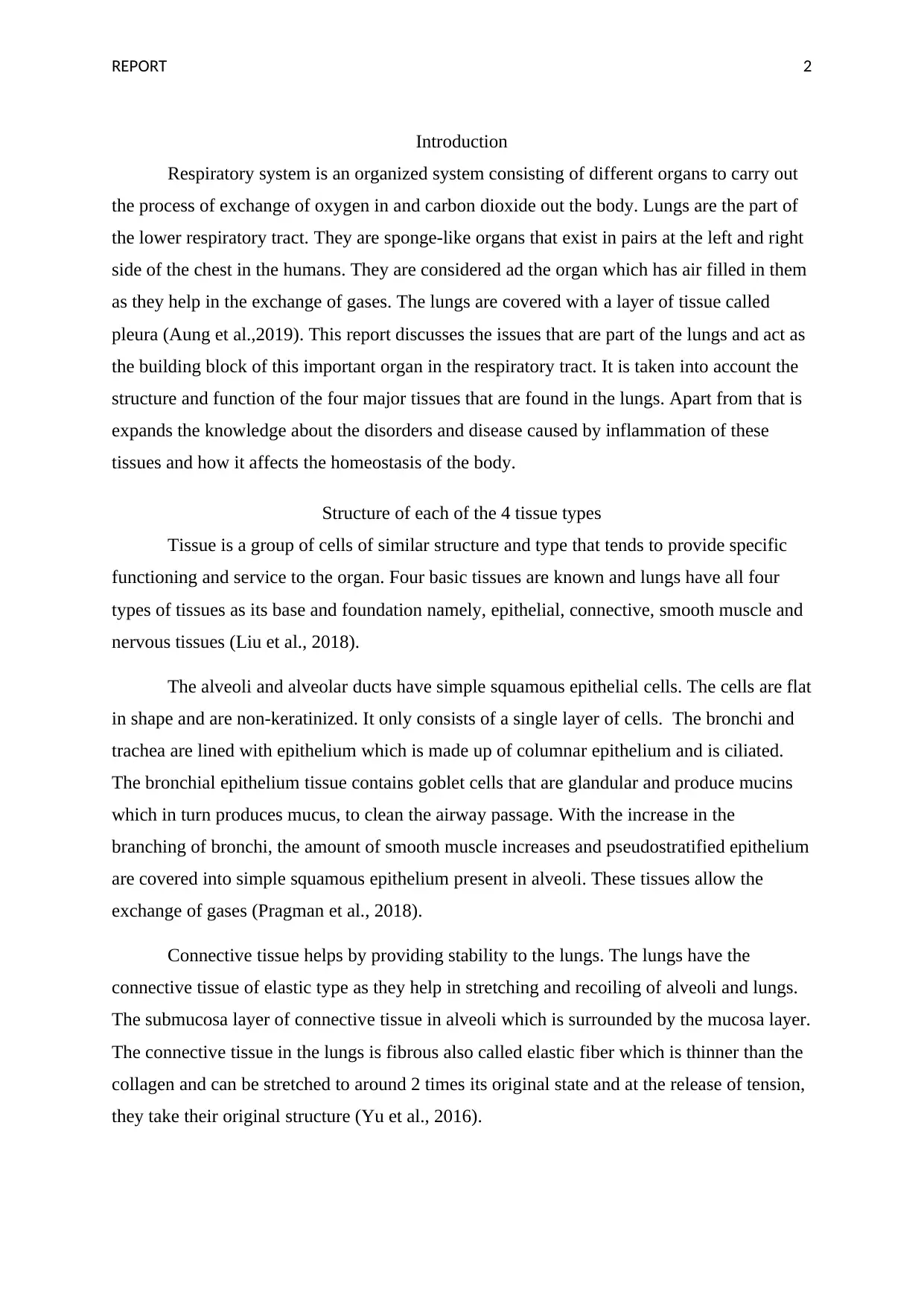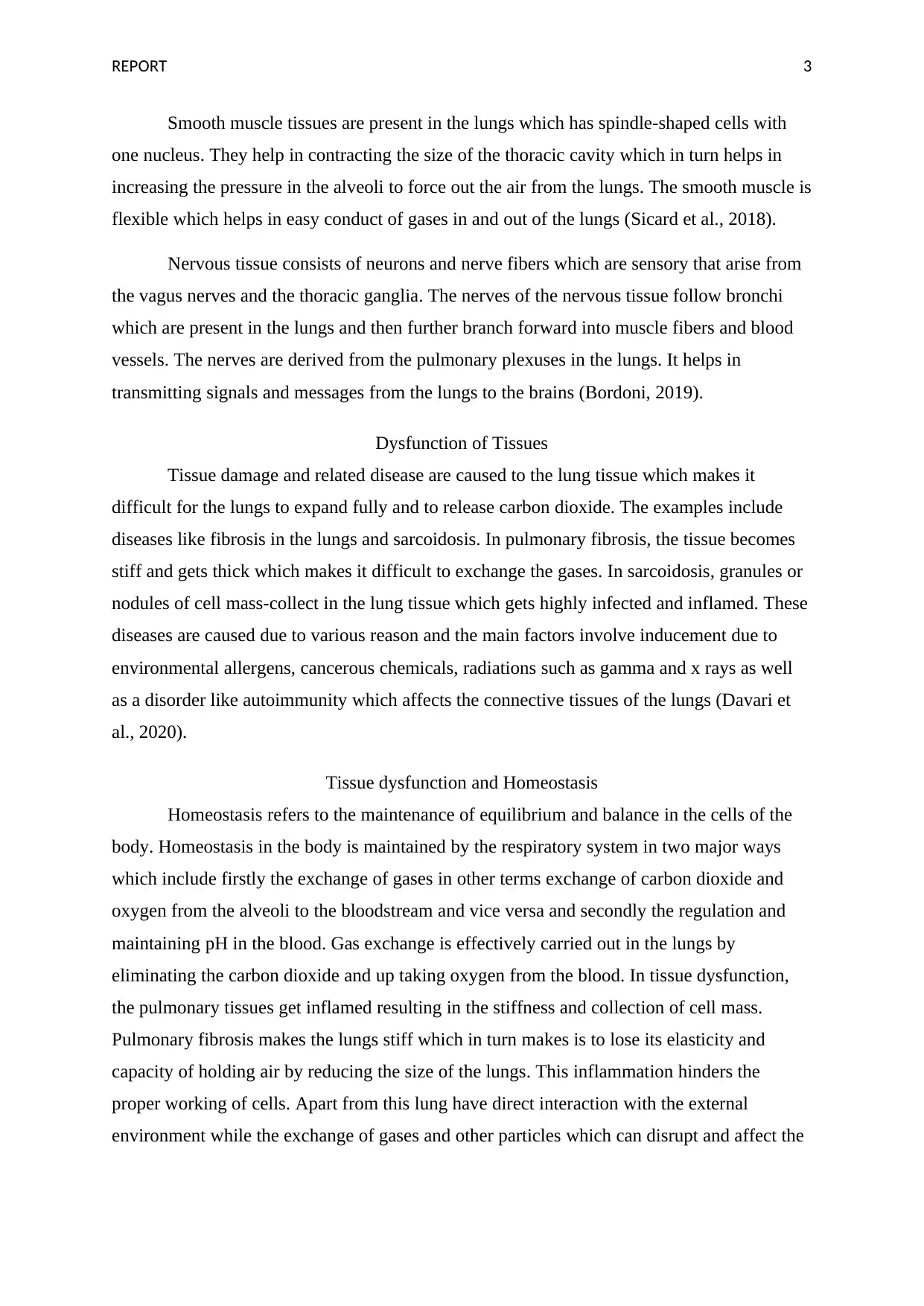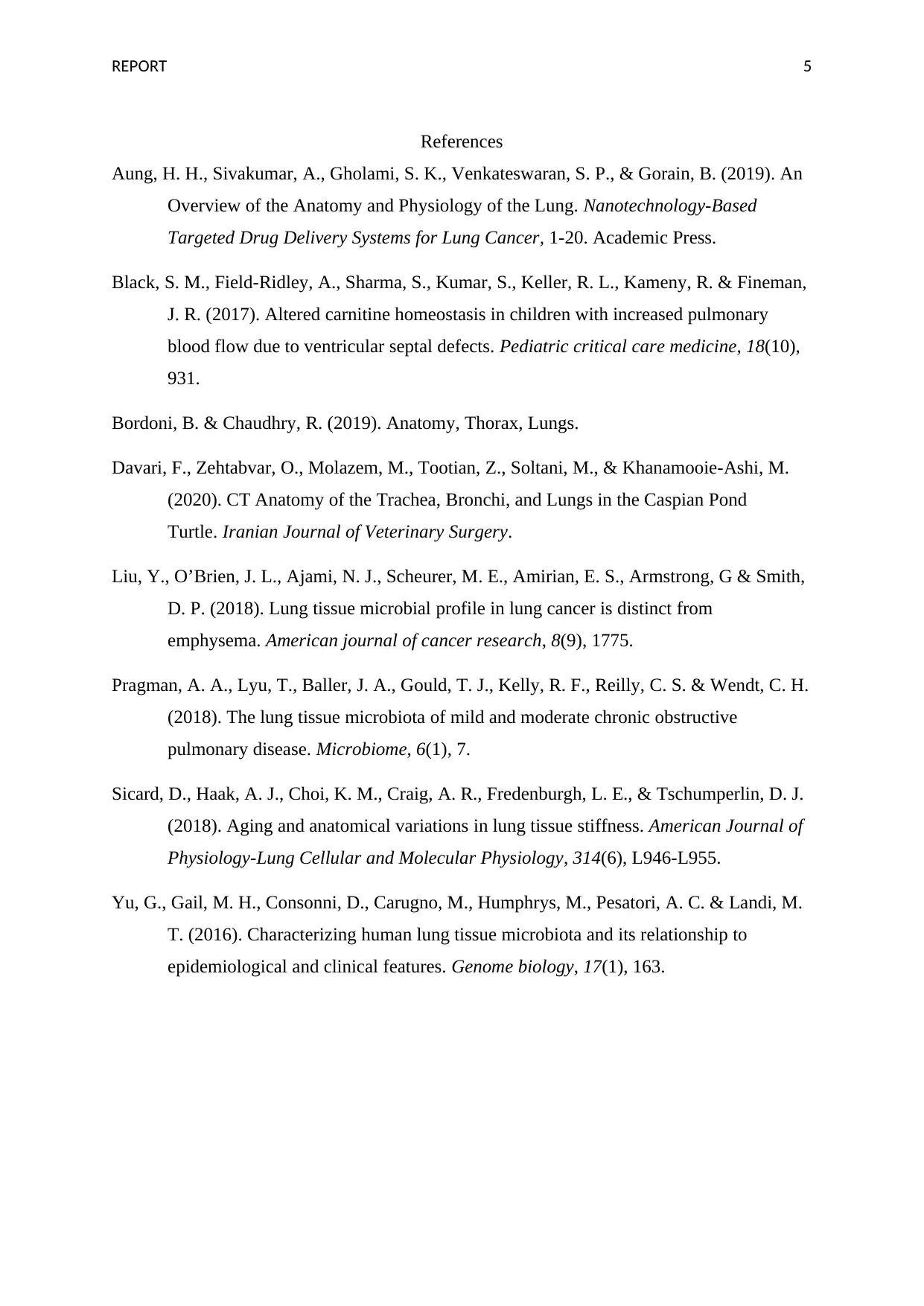1805NRS Trimester 1 Report: Anatomy and Physiology of the Lungs
VerifiedAdded on 2022/09/14
|6
|1487
|70
Report
AI Summary
This report provides a detailed analysis of the anatomy and physiology of the lungs, focusing on the structure and function of the four major tissue types: epithelial, connective, smooth muscle, and nervous tissues. It explains how each tissue contributes to the overall function of the lungs, including gas exchange and structural support. The report then examines the dysfunction of specific tissue types, such as pulmonary fibrosis and sarcoidosis, and how these conditions disrupt the homeostatic mechanisms of the respiratory system, particularly affecting gas exchange and the regulation of blood pH. The report emphasizes the importance of healthy lung tissue for maintaining overall body homeostasis and discusses the impact of environmental factors and diseases on lung function. The report concludes by highlighting the crucial role of the lungs in human survival and the potential risks associated with tissue dysfunction. References are provided to support the claims made in the report.

Anatomy and Physiology
Biology
REPORT 0
Biology
REPORT 0
Paraphrase This Document
Need a fresh take? Get an instant paraphrase of this document with our AI Paraphraser

REPORT 1
Contents
Introduction................................................................................................................................2
Structure of each of the 4 tissue types........................................................................................2
Dysfunction of Tissues...............................................................................................................3
Tissue disfunction and Homeostasis..........................................................................................3
Conclusion..................................................................................................................................4
References..................................................................................................................................5
Contents
Introduction................................................................................................................................2
Structure of each of the 4 tissue types........................................................................................2
Dysfunction of Tissues...............................................................................................................3
Tissue disfunction and Homeostasis..........................................................................................3
Conclusion..................................................................................................................................4
References..................................................................................................................................5

REPORT 2
Introduction
Respiratory system is an organized system consisting of different organs to carry out
the process of exchange of oxygen in and carbon dioxide out the body. Lungs are the part of
the lower respiratory tract. They are sponge-like organs that exist in pairs at the left and right
side of the chest in the humans. They are considered ad the organ which has air filled in them
as they help in the exchange of gases. The lungs are covered with a layer of tissue called
pleura (Aung et al.,2019). This report discusses the issues that are part of the lungs and act as
the building block of this important organ in the respiratory tract. It is taken into account the
structure and function of the four major tissues that are found in the lungs. Apart from that is
expands the knowledge about the disorders and disease caused by inflammation of these
tissues and how it affects the homeostasis of the body.
Structure of each of the 4 tissue types
Tissue is a group of cells of similar structure and type that tends to provide specific
functioning and service to the organ. Four basic tissues are known and lungs have all four
types of tissues as its base and foundation namely, epithelial, connective, smooth muscle and
nervous tissues (Liu et al., 2018).
The alveoli and alveolar ducts have simple squamous epithelial cells. The cells are flat
in shape and are non-keratinized. It only consists of a single layer of cells. The bronchi and
trachea are lined with epithelium which is made up of columnar epithelium and is ciliated.
The bronchial epithelium tissue contains goblet cells that are glandular and produce mucins
which in turn produces mucus, to clean the airway passage. With the increase in the
branching of bronchi, the amount of smooth muscle increases and pseudostratified epithelium
are covered into simple squamous epithelium present in alveoli. These tissues allow the
exchange of gases (Pragman et al., 2018).
Connective tissue helps by providing stability to the lungs. The lungs have the
connective tissue of elastic type as they help in stretching and recoiling of alveoli and lungs.
The submucosa layer of connective tissue in alveoli which is surrounded by the mucosa layer.
The connective tissue in the lungs is fibrous also called elastic fiber which is thinner than the
collagen and can be stretched to around 2 times its original state and at the release of tension,
they take their original structure (Yu et al., 2016).
Introduction
Respiratory system is an organized system consisting of different organs to carry out
the process of exchange of oxygen in and carbon dioxide out the body. Lungs are the part of
the lower respiratory tract. They are sponge-like organs that exist in pairs at the left and right
side of the chest in the humans. They are considered ad the organ which has air filled in them
as they help in the exchange of gases. The lungs are covered with a layer of tissue called
pleura (Aung et al.,2019). This report discusses the issues that are part of the lungs and act as
the building block of this important organ in the respiratory tract. It is taken into account the
structure and function of the four major tissues that are found in the lungs. Apart from that is
expands the knowledge about the disorders and disease caused by inflammation of these
tissues and how it affects the homeostasis of the body.
Structure of each of the 4 tissue types
Tissue is a group of cells of similar structure and type that tends to provide specific
functioning and service to the organ. Four basic tissues are known and lungs have all four
types of tissues as its base and foundation namely, epithelial, connective, smooth muscle and
nervous tissues (Liu et al., 2018).
The alveoli and alveolar ducts have simple squamous epithelial cells. The cells are flat
in shape and are non-keratinized. It only consists of a single layer of cells. The bronchi and
trachea are lined with epithelium which is made up of columnar epithelium and is ciliated.
The bronchial epithelium tissue contains goblet cells that are glandular and produce mucins
which in turn produces mucus, to clean the airway passage. With the increase in the
branching of bronchi, the amount of smooth muscle increases and pseudostratified epithelium
are covered into simple squamous epithelium present in alveoli. These tissues allow the
exchange of gases (Pragman et al., 2018).
Connective tissue helps by providing stability to the lungs. The lungs have the
connective tissue of elastic type as they help in stretching and recoiling of alveoli and lungs.
The submucosa layer of connective tissue in alveoli which is surrounded by the mucosa layer.
The connective tissue in the lungs is fibrous also called elastic fiber which is thinner than the
collagen and can be stretched to around 2 times its original state and at the release of tension,
they take their original structure (Yu et al., 2016).
⊘ This is a preview!⊘
Do you want full access?
Subscribe today to unlock all pages.

Trusted by 1+ million students worldwide

REPORT 3
Smooth muscle tissues are present in the lungs which has spindle-shaped cells with
one nucleus. They help in contracting the size of the thoracic cavity which in turn helps in
increasing the pressure in the alveoli to force out the air from the lungs. The smooth muscle is
flexible which helps in easy conduct of gases in and out of the lungs (Sicard et al., 2018).
Nervous tissue consists of neurons and nerve fibers which are sensory that arise from
the vagus nerves and the thoracic ganglia. The nerves of the nervous tissue follow bronchi
which are present in the lungs and then further branch forward into muscle fibers and blood
vessels. The nerves are derived from the pulmonary plexuses in the lungs. It helps in
transmitting signals and messages from the lungs to the brains (Bordoni, 2019).
Dysfunction of Tissues
Tissue damage and related disease are caused to the lung tissue which makes it
difficult for the lungs to expand fully and to release carbon dioxide. The examples include
diseases like fibrosis in the lungs and sarcoidosis. In pulmonary fibrosis, the tissue becomes
stiff and gets thick which makes it difficult to exchange the gases. In sarcoidosis, granules or
nodules of cell mass-collect in the lung tissue which gets highly infected and inflamed. These
diseases are caused due to various reason and the main factors involve inducement due to
environmental allergens, cancerous chemicals, radiations such as gamma and x rays as well
as a disorder like autoimmunity which affects the connective tissues of the lungs (Davari et
al., 2020).
Tissue dysfunction and Homeostasis
Homeostasis refers to the maintenance of equilibrium and balance in the cells of the
body. Homeostasis in the body is maintained by the respiratory system in two major ways
which include firstly the exchange of gases in other terms exchange of carbon dioxide and
oxygen from the alveoli to the bloodstream and vice versa and secondly the regulation and
maintaining pH in the blood. Gas exchange is effectively carried out in the lungs by
eliminating the carbon dioxide and up taking oxygen from the blood. In tissue dysfunction,
the pulmonary tissues get inflamed resulting in the stiffness and collection of cell mass.
Pulmonary fibrosis makes the lungs stiff which in turn makes is to lose its elasticity and
capacity of holding air by reducing the size of the lungs. This inflammation hinders the
proper working of cells. Apart from this lung have direct interaction with the external
environment while the exchange of gases and other particles which can disrupt and affect the
Smooth muscle tissues are present in the lungs which has spindle-shaped cells with
one nucleus. They help in contracting the size of the thoracic cavity which in turn helps in
increasing the pressure in the alveoli to force out the air from the lungs. The smooth muscle is
flexible which helps in easy conduct of gases in and out of the lungs (Sicard et al., 2018).
Nervous tissue consists of neurons and nerve fibers which are sensory that arise from
the vagus nerves and the thoracic ganglia. The nerves of the nervous tissue follow bronchi
which are present in the lungs and then further branch forward into muscle fibers and blood
vessels. The nerves are derived from the pulmonary plexuses in the lungs. It helps in
transmitting signals and messages from the lungs to the brains (Bordoni, 2019).
Dysfunction of Tissues
Tissue damage and related disease are caused to the lung tissue which makes it
difficult for the lungs to expand fully and to release carbon dioxide. The examples include
diseases like fibrosis in the lungs and sarcoidosis. In pulmonary fibrosis, the tissue becomes
stiff and gets thick which makes it difficult to exchange the gases. In sarcoidosis, granules or
nodules of cell mass-collect in the lung tissue which gets highly infected and inflamed. These
diseases are caused due to various reason and the main factors involve inducement due to
environmental allergens, cancerous chemicals, radiations such as gamma and x rays as well
as a disorder like autoimmunity which affects the connective tissues of the lungs (Davari et
al., 2020).
Tissue dysfunction and Homeostasis
Homeostasis refers to the maintenance of equilibrium and balance in the cells of the
body. Homeostasis in the body is maintained by the respiratory system in two major ways
which include firstly the exchange of gases in other terms exchange of carbon dioxide and
oxygen from the alveoli to the bloodstream and vice versa and secondly the regulation and
maintaining pH in the blood. Gas exchange is effectively carried out in the lungs by
eliminating the carbon dioxide and up taking oxygen from the blood. In tissue dysfunction,
the pulmonary tissues get inflamed resulting in the stiffness and collection of cell mass.
Pulmonary fibrosis makes the lungs stiff which in turn makes is to lose its elasticity and
capacity of holding air by reducing the size of the lungs. This inflammation hinders the
proper working of cells. Apart from this lung have direct interaction with the external
environment while the exchange of gases and other particles which can disrupt and affect the
Paraphrase This Document
Need a fresh take? Get an instant paraphrase of this document with our AI Paraphraser

REPORT 4
homeostasis of iron. Exposure to lets like bleomycin and dust fibers changes the iron
homeostasis in the lungs. (Black et al., 2017).
Conclusion
Hence, this report deduces the facts about the lung and the diversified types of the
tissues play a major role in maintaining the structure of the lungs and aids them in carrying
out the process of gas exchange. It helps in the survival of the humans. Hence, the
dysfunction of the lungs can bring risks to life and must be prevented. It is well reflected how
the tissue dysfunction affects the homeostasis of the lungs and the body.
homeostasis of iron. Exposure to lets like bleomycin and dust fibers changes the iron
homeostasis in the lungs. (Black et al., 2017).
Conclusion
Hence, this report deduces the facts about the lung and the diversified types of the
tissues play a major role in maintaining the structure of the lungs and aids them in carrying
out the process of gas exchange. It helps in the survival of the humans. Hence, the
dysfunction of the lungs can bring risks to life and must be prevented. It is well reflected how
the tissue dysfunction affects the homeostasis of the lungs and the body.

REPORT 5
References
Aung, H. H., Sivakumar, A., Gholami, S. K., Venkateswaran, S. P., & Gorain, B. (2019). An
Overview of the Anatomy and Physiology of the Lung. Nanotechnology-Based
Targeted Drug Delivery Systems for Lung Cancer, 1-20. Academic Press.
Black, S. M., Field-Ridley, A., Sharma, S., Kumar, S., Keller, R. L., Kameny, R. & Fineman,
J. R. (2017). Altered carnitine homeostasis in children with increased pulmonary
blood flow due to ventricular septal defects. Pediatric critical care medicine, 18(10),
931.
Bordoni, B. & Chaudhry, R. (2019). Anatomy, Thorax, Lungs.
Davari, F., Zehtabvar, O., Molazem, M., Tootian, Z., Soltani, M., & Khanamooie-Ashi, M.
(2020). CT Anatomy of the Trachea, Bronchi, and Lungs in the Caspian Pond
Turtle. Iranian Journal of Veterinary Surgery.
Liu, Y., O’Brien, J. L., Ajami, N. J., Scheurer, M. E., Amirian, E. S., Armstrong, G & Smith,
D. P. (2018). Lung tissue microbial profile in lung cancer is distinct from
emphysema. American journal of cancer research, 8(9), 1775.
Pragman, A. A., Lyu, T., Baller, J. A., Gould, T. J., Kelly, R. F., Reilly, C. S. & Wendt, C. H.
(2018). The lung tissue microbiota of mild and moderate chronic obstructive
pulmonary disease. Microbiome, 6(1), 7.
Sicard, D., Haak, A. J., Choi, K. M., Craig, A. R., Fredenburgh, L. E., & Tschumperlin, D. J.
(2018). Aging and anatomical variations in lung tissue stiffness. American Journal of
Physiology-Lung Cellular and Molecular Physiology, 314(6), L946-L955.
Yu, G., Gail, M. H., Consonni, D., Carugno, M., Humphrys, M., Pesatori, A. C. & Landi, M.
T. (2016). Characterizing human lung tissue microbiota and its relationship to
epidemiological and clinical features. Genome biology, 17(1), 163.
References
Aung, H. H., Sivakumar, A., Gholami, S. K., Venkateswaran, S. P., & Gorain, B. (2019). An
Overview of the Anatomy and Physiology of the Lung. Nanotechnology-Based
Targeted Drug Delivery Systems for Lung Cancer, 1-20. Academic Press.
Black, S. M., Field-Ridley, A., Sharma, S., Kumar, S., Keller, R. L., Kameny, R. & Fineman,
J. R. (2017). Altered carnitine homeostasis in children with increased pulmonary
blood flow due to ventricular septal defects. Pediatric critical care medicine, 18(10),
931.
Bordoni, B. & Chaudhry, R. (2019). Anatomy, Thorax, Lungs.
Davari, F., Zehtabvar, O., Molazem, M., Tootian, Z., Soltani, M., & Khanamooie-Ashi, M.
(2020). CT Anatomy of the Trachea, Bronchi, and Lungs in the Caspian Pond
Turtle. Iranian Journal of Veterinary Surgery.
Liu, Y., O’Brien, J. L., Ajami, N. J., Scheurer, M. E., Amirian, E. S., Armstrong, G & Smith,
D. P. (2018). Lung tissue microbial profile in lung cancer is distinct from
emphysema. American journal of cancer research, 8(9), 1775.
Pragman, A. A., Lyu, T., Baller, J. A., Gould, T. J., Kelly, R. F., Reilly, C. S. & Wendt, C. H.
(2018). The lung tissue microbiota of mild and moderate chronic obstructive
pulmonary disease. Microbiome, 6(1), 7.
Sicard, D., Haak, A. J., Choi, K. M., Craig, A. R., Fredenburgh, L. E., & Tschumperlin, D. J.
(2018). Aging and anatomical variations in lung tissue stiffness. American Journal of
Physiology-Lung Cellular and Molecular Physiology, 314(6), L946-L955.
Yu, G., Gail, M. H., Consonni, D., Carugno, M., Humphrys, M., Pesatori, A. C. & Landi, M.
T. (2016). Characterizing human lung tissue microbiota and its relationship to
epidemiological and clinical features. Genome biology, 17(1), 163.
⊘ This is a preview!⊘
Do you want full access?
Subscribe today to unlock all pages.

Trusted by 1+ million students worldwide
1 out of 6
Related Documents
Your All-in-One AI-Powered Toolkit for Academic Success.
+13062052269
info@desklib.com
Available 24*7 on WhatsApp / Email
![[object Object]](/_next/static/media/star-bottom.7253800d.svg)
Unlock your academic potential
Copyright © 2020–2025 A2Z Services. All Rights Reserved. Developed and managed by ZUCOL.





